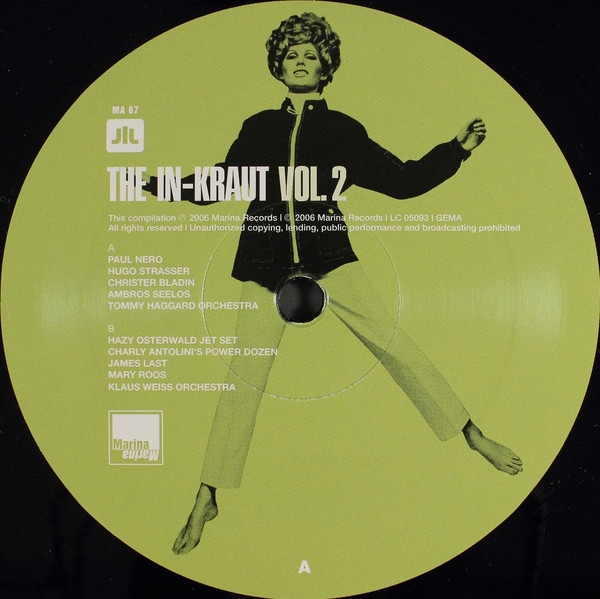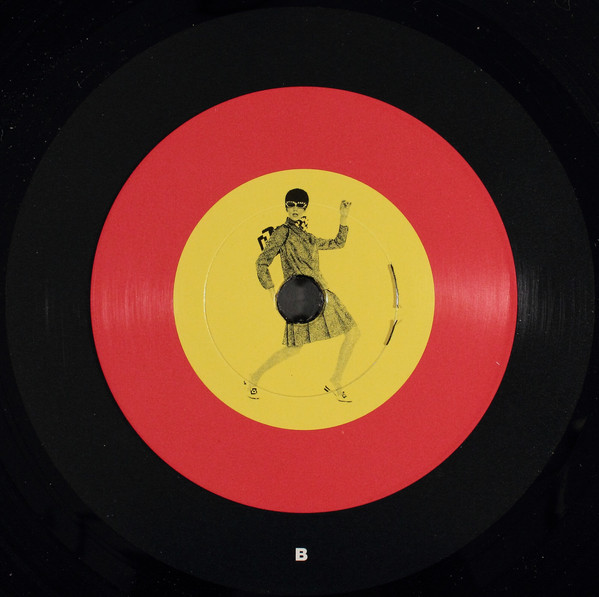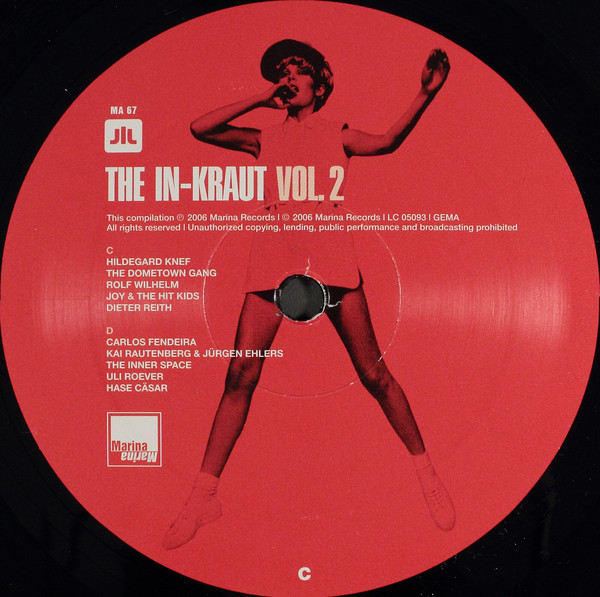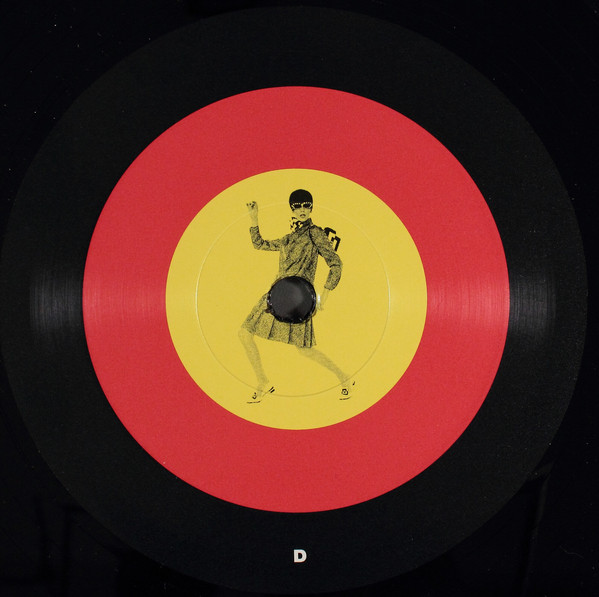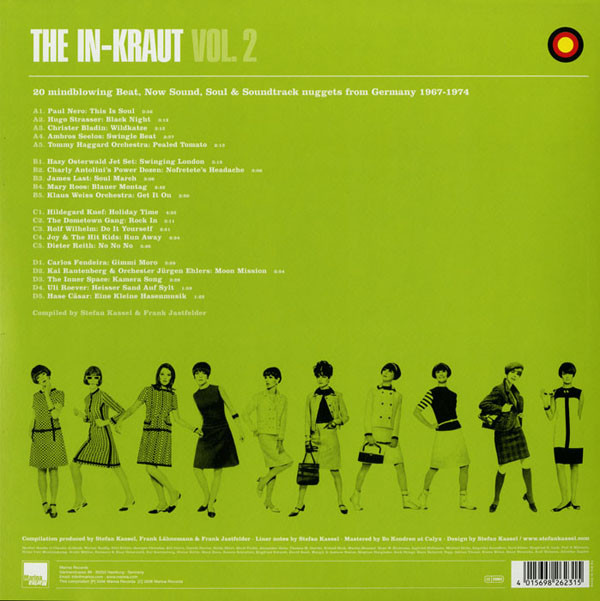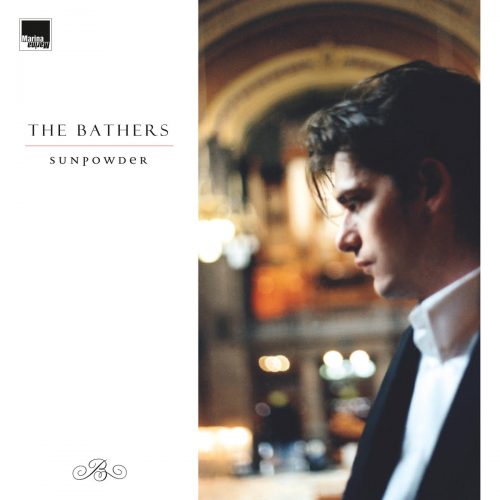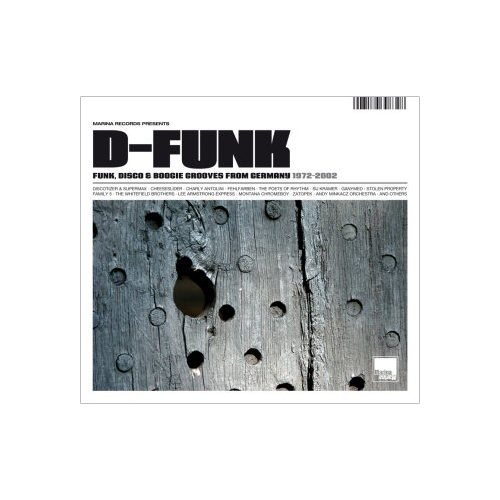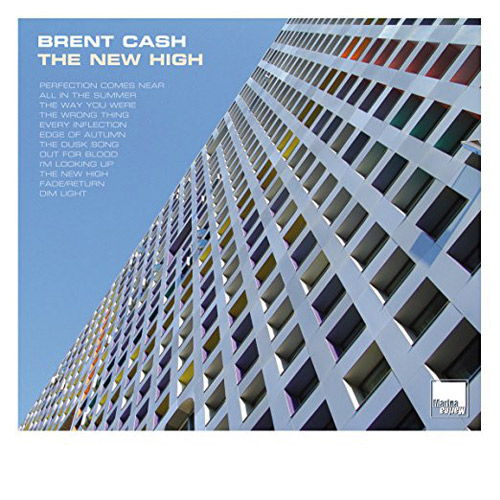Artist: Various Artists
Title: THE IN-KRAUT Vol 2 – Hip Shaking Grooves Made In Germany 1967-1974
Format: 2-LP
Label: Marina Records
Release date: October 27, 2006
Various Artists – The In-Kraut Vol. 2 2-LP
€33,00
Description
20 mindblowing Beat, Now Sound, Soul & Soundtrack nuggets
01. Paul Nero: This Is Soul
02. Hugo Strasser: Black Night
03. Christer Bladin: Wildkatze
04. Ambros Seelos: Swingle Beat
05. Tommy Haggard Orchestra: Pealed Tomato
06. Hazy Osterwald Jet Set: Swinging London
07. Charly Antolini’s Power Dozen: Nofretete’s Headache
08. James Last: Soul March
09. Mary Roos: Blauer Montag
10. Klaus Weiss Orchestra: Get It On
11. Hildegard Knef: Holiday Time
12. The Dometown Gang: Rock In
13. Rolf Wilhelm: Do It Yourself
14. Joy & The Hit Kids: Run Away
15. Dieter Reith: No No No
16. Carlos Fendeira: Gimmi Moro
17. Kai Rautenberg & Orchester Jürgen Ehlers: Moon Mission
18. The Inner Space: Kamera Song
19. Uli Roever: Heisser Sand Auf Sylt
20. Hase Cäsar: Eine Kleine Hasenmusik
Compiled by Stefan Kassel & Frank Jastfelder
Liner notes by Stefan Kassel
Mastered by Bo Kondren at Calyx, Berlin
Art Direction & Design by Stefan Kassel / www.stefankassel.com
Compilation produced by Stefan Kassel, Frank Lähnemann & Frank Jastfelder
Release date: October 27, 2006 (MA 67)
Additional information
| Weight | 0,460 kg |
|---|
Track by track notes
Liner notes by Stefan Kassel
01. Paul Nero: This Is Soul
“You hear this? Drums. Swinging drums…” Willkommen to the second installment of The In-Kraut. Wolfgang Paap’s kick-ass drums set the mood, and he’s quickly joined by In-Kraut regulars Lothar Meid (bass), Siegfried Schwab (guitar) and Ingfried Hoffmann (organ). The icing on the cake is supplied by the man on tenor saxophone: German jazz legend Klaus Doldinger (*1936) aka Paul Nero. In a career spanning five decades Mr Doldinger recorded more than 50 LPs and won numerous jazz awards. He also composed many memorable soundtracks including “Negresco” (1968), “Das Boot” (1981) and the classic title theme to “Tatort”, German TV’s longest running crime series. Doldinger also made waves with his successful jazz fusion outfit Passport, which is still active to this day. For his more commercial releases in the late 60s – usually in the “Non Stop Dancing” medley format – he used the Paul Nero moniker. “This Is Soul”, an obvious homage to the King Curtis classic “Memphis Soul Stew”, stems from Nero’s cool 1968 album “Nero’s Soul Party”, which featured lots of groovy cover versions from the Stax and Atlantic catalogue.
02. Hugo Strasser: Black Night
This is almost too good to be true: Hugo Strasser (*1922), Germany’s first ambassador of swing, tackles Deep Purple. And how! His powerhouse version of “Black Night”, the heavy rocker’s first UK hit, is as sharp as it gets. The hard swinging arrangement was written by saxophonist Werner Tauber (1934-2001), a long-time member of Strasser’s band. The track originally appeared on “Tanzhits ‘71”, Mr Strasser’s most In-Kraut sounding record ever. It features stellar versions of rock hits like “Paranoid”, “The Witch” and “Jingo” – all propelled to new heights by superb arrangements and super-tight playing. The album was part of Strasser’s regular “Tanzplatte Des Jahres” (Dance Record Of The Year) series, which ran successfully for a period of over 30 years. Strasser’s long career began as a clarinetist in post-war Germany, playing swing and jazz in American GI clubs as part of the Max Greger Sextet. In 1955 he formed his own orchestra which became an instant success. Over the decades he recorded countless albums and was a constant fixture on German TV. King Hugo is still in demand these days: Since 2000 he has performed regularly with Max Greger and Paul Kuhn under the name “Swing Legends” – to sold-out venues and enthusiastic responses. A true giant.
03. Christer Bladin: Wildkatze
Wildkatze! This is as good as it gets. Since we first discovered the bouncy “Wildkatze” (Wild Cat), it has never failed to put us into hysterics. Its mad “sexy” lyrics (describing a way hot lady, i. e. wild cat!), its “authentic” cat noises and its irresistible rhythm made us instantly fall in love with it. Call it Mondo In-Kraut, call it whatever, it sure rocks our world. The track was written by none other than In-Kraut hero Mr Dieter Reith (see notes to “No No No”). It’s the title song to a bizarre independent movie called “Gina Wildkatze” from 1974. It stars red-light “madam” Gina von Freiburg (aka Gina Arnold) who also wrote, directed and financed this odd independent venture! “Wildkatze” is sung by Gina’s male co-star Christer Bladin, nowadays an acclaimed classical tenor. The song only appeared on a rare, privately pressed 7” single – featuring a cover depicting Fräulein von Freiburg letting it all hang out. As Franz Ferdinand might say: Simply super-fantastisch…
04. Ambros Seelos: Swingle Beat
Saxophone king Ambros Seelos (*1935) is one of a kind – a true urgestein of the German music scene. He started his own show band way back in 1960, and still tours the world to this day. Always accompanied by top-flight musicians, he never had a problem adapting his style to the changing times – be it big band swing or 70s cop show funk. His hip stage persona sparkles with charisma, humor and wit. And he sure knows how to work a crowd. Audiences instantly notice: This guy really enjoys his job. And they love him for it. During the 60s he recorded a whole bunch of entertaining groove jazz records for the famous MPS label. “Swingle Beat” hails from the highly collectable “Fire” album (1968). The intoxicating track immediately makes you wanna hit the dancefloor and shake some action. Damenwahl! We can only agree, Mr Seelos: One more time – pleeease! Interesting footnote: Long-time Ambros Seelos band member Sylvester Levay – who arranged “Swingle Beat” and also played the fantastic Hammond organ part – went on to compose the worldwide disco smash hits “Fly Robin Fly” and “Get Up And Boogie” for Silver Convention!
05. Tommy Haggard Orchestra: Pealed Tomato
Fasten your seat belts, ladies and gentlemen, here’s a real In-Kraut nugget: The uplifting “Pealed Tomato” is sophisticated to the core and full of exciting little twists and turns. Play it over and over again, and you’ll still discover another cool little detail. Just check out the crazy vocals and the mad solo guitar! The song was originally cut in 1968 for a library music production by Bavaria’s Raphaele Records. The big question: Who the hell is Tommy Haggard?! The fact is, he didn’t really exist. It was a nom de plume for a bunch of studio cats who used the Tommy Haggard moniker solely for their Raphaele recordings – among them such top-notch players as Benny Bailey (trumpet) and Pierre Cavalli (guitar). The song was written by pianist/arranger Georges Chorafas (*1927), musical director of Switzerland’s popular TV show “La Grande Chance” (1974-1979). That’s about all that is known about this long-lost masterpiece. Just turn it up and let it groove ya!
06. Hazy Osterwald Jet Set: Swinging London
“Piccadilly… Carnaby Street! Swinging London! Marble Arch to Regent Street…” It may sound like a lost single by Acid Jazz veterans Corduroy, but this is in fact the work of Hazy Osterwald (*1922), one of Switzerland’s most successful music exports, and surely one of Europe’s hardest working men in showbiz. Starting out with the Hazy Osterwald Sextet way back in 1949, he constantly toured the globe – often playing up to 300 dates a year. He appeared in movies, scored huge hits (“Kriminaltango”, 1959), ran his own record label (Mabel) and even owned a string of nightclubs (Hazyland). Though his first love was swing (writing arrangements for Teddy Stauffer as a teenager!), he always kept in with The In-Kraut. After a couple of line-up changes he even renamed his sextet to the more “now”-sounding Hazy Osterwald Jet Set – and cut such cool tunes as “Swinging London”. Kicking off with the sound of Big Ben, the track is a great piece of In-Kraut bubblegum. Osterwald’s fantastic band – honed to perfection by constant live engagements – delivers a true knock-out performance. The Jet Set included John Ward (drums), Curt Prina (organ), Bob Glower (saxophone), Peter Meller (guitar), Franco Bussmann (bass) and Hazy himself on trumpet. “Ding-dong, ding-dong…”
07. Charly Antolini’s Power Dozen: Nofretete’s Headache
Drums R Us. If one guy could make that claim, it surely would be Mr Charly Antolini (*1937), one of Europe’s most distinctive drummers ever – and one of the few who actually made a name for himself. After attending the Academy of Music in Zürich, he started his professional career with the Erwin Lehn Orchestra, and later moved on to the red-hot Max Greger band and the NDR Big Band. Along the way Antolini became an in-demand studio drummer and also issued solo records from time to time. “Nofretete’s Headache” (what a song title!) is taken from his incredibly rare “Atomic Drums” album (1972) – brilliantly recorded by engineer Willi Schmidt at Munich’s legendary Trixi studio. The track was written by the album’s producer/arranger Eric Thöner who cut a similar, though slightly less rocking version of the song for his album “Piano Explosion” (BASF, 1974). The entire “Atomic Drums” album is highly recommended. It’s jampacked with monster breakbeats and killer grooves – the kind of stuff that hip-hop producers would kill for. It’s no wonder that the record rocks like a mothershark: Antolini’s “Power Dozen” included such ace musicians as Max Greger Jr. (organ), Michael Goltz (guitar), Milan Pilar (bass), Egon Haag (flute, saxophone) and Harry Winkler (lead guitar). Wunderbar!
08. James Last: Soul March
His name is Last. James Last. He released more than 200 albums. He’s the world’s most successful bandleader. He earned 206 gold and 17 platinum discs. The critics never liked him. So what?! James “Hansi” Last (*1929) is Germany’s bestselling music export ever. His “Non Stop Dancing” LP series was the soundtrack to every house party in 60s and 70s Germany. And yet, James’s sound was usually too polished and bland for The In-Kraut. The funky “Soul March” – written by the man himself – is a whole different story though. Only issued as the 7” flipside to his worldwide hit “Happy Heart”, it is the most unusual nugget in the James Last catalogue. The unique combination of a marching rhythm and a groovy tune is really something else – most suitable for cage-dancing and other delights. Just give it a spin and watch what happens. Mr Last, now approaching 80, stills tours the world today. Chances are slim, however, that “Soul March” would make his playlist these days.
09. Mary Roos: Blauer Montag
There’s no doubt: Mary Roos (*1949) is our all-time favorite German vocalist. Her impeccable, effortlessly flowing singing style is simply the bomb. Call her the German Dionne Warwick and you’re not too far off the mark. Fräulein Roos’s career started way back in 1958. At the tender age of nine the little wunderkind released her first single as “Rosemarie”. It was the beginning of a long and successful career in music, which has lasted up to this day. Though her talents were sometimes wasted on mediocre Schlager, Miss Roos recorded quite a few stand-out albums – some of them even in French. The fantastic “Blauer Montag” (Blue Monday) hails from her self-titled album from 1970 (featuring the Giorgio Moroder-written hit single “Arizona Man”). Her treatment of Jorge Ben’s “Mas Que Nada” (a worldwide hit for Sergio Mendes & Brasil ’66) oozes with style and verve – backed by a true killer band. The superb German lyrics were written by the track’s producer Michael Holm, a Schlager star in his own right (“Tränen Lügen Nicht”). In 1972 and 1984 Roos represented Germany at the Eurovision Song Contest.
10. Klaus Weiss Orchestra: Get It On
Drummer extraordinaire Klaus Weiss (*1942) is one of Germany’s best and most recorded jazz musicians. As Johnny Griffin once observed: “He is one of the few European drummers with that distinctive American feeling.” Weiss, winner of several jazz polls, is probably best known for his work with the Klaus Doldinger Quartet, Friedrich Gulda and Horst Jankowski. Besides his numerous studio and live commitments he nurtured such exciting solo projects as the Klaus Weiss Orchestra. “Get It On” was recorded during a week-long live engagement at Munich’s famous jazz club The Domicile. Weiss: “Crowds were lining up around the block to see our show…” Listen to this super-sharp performance and you’ll know why. The 16-strong KW Orchestra is just mindblowing – featuring such hot players as Klaus Weiss himself on drums, Chuck Findley (trumpet), Don Menza (saxophone), Slide Hampton (trombone), Philip Catherine (guitar) and Fritz Pauer (e-piano). “Get It On” was originally a one-hit wonder for American brass-heavy outfit Chase, making the US Top 40 in 1971. The KW Orchestra’s version got rid of the slightly annoying vocals, and Ingfried Hoffmann’s new arrangement even tops the original. Play it loud and – get it on (bang a gong)!
11. Hildegard Knef: Holiday Time
“They came back from the moon today, one of the parachutes didn’t open…” After kickstarting the first volume of our compilation series in such memorable fashion (“From Here On It Got Rough”), Miss Knef (1925-2002) makes yet another stunning In-Kraut appearance. The incredible “Holiday Time” is Kraut-a-delica in excelsis. On top of a killer bassline, Hilde delivers a psychedelic proto-rap that has to be heard to be believed. Is this the moment when hip-hop was born?! Hilde’s sensational lyrics (translated by her then-husband David Cameron) were so far ahead of their time that they still hit the zeitgeist today. Grandmaster Flash & The Furious Five couldn’t deliver a more appropriate picture of our crazy times. The song’s original German version (“Ferienzeit”) was released on Knef’s “Worum Geht’s Hier Eigentlich” album in 1971. This extremely rare English version appeared, strangely enough, only on a 7” b-side in France (of all places)! Arranger & co-composer Hans Hammerschmid (*1930) was responsible for many of Knef’s best songs including her biggest ever hit “Für Mich Soll’s Rote Rosen Regnen”. “Holiday Time”, however, remains their coolest and most unusual team effort. “Slaughter in Pakistan, slaughter on the Autobahn…”
12. The Dometown Gang: Rock In
Here’s another real In-Kraut rarity. Issued as a 7” b-side in 1968, it has all the ingredients of a nice Teutonic floorshaker: A fat thumping Go-Go beat, a sharp horn section and a crazy stretched-out organ solo. The Dometown Gang was a studio project featuring several members of the cool Kurt Edelhagen Orchestra from Cologne (hence the name Dometown Gang!). It was the brainchild of Heinz Gietz (1924-1989), owner of the groovy Cornet label. Mr Gietz – who wrote, arranged and produced the song – was a real music heavyweight. He scored movies, ran his own record company and composed countless hits for artists like Caterina Valente, Cindy & Bert, Bill Ramsey and Gitte. “Rock In” is the flipside to “The Killer Of Soho”, the Gietz-written theme song to a movie that unfortunately was never completed, meaning the single only had a very limited shelf life and is now very hard to find. Make sure to check out the single’s wacky cover art, another fine example of Cornet’s truly unique approach to sleeve design! And, hey kids: Don’t rock in – rock out!
13. Rolf Wilhelm: Do It Yourself
Soundtrack veteran Rolf Wilhelm (*1927) is one of Germany’s most prolific composers ever. He scored more than 500 TV and film productions. Among them are such classics as Ingmar Bergman’s “The Serpent’s Egg” (1976), the war trilogy “08/15” (1954/5) and an ambitious two-part movie version of the Nibelungen saga (1967). Fortunately Mr Wilhelm could not only set the götterdämmerung to music, he also knew how to cook up some super-fine In-Kraut. The groovy “Do It Yourself” was written for the oddly named TV series “Gestern Gelesen” (Read Yesterday), a programme that featured the many cases of trial lawyer Dr. Peter Fuhrmann (played by Erik Schumann). 52 episodes were screened from 1969 to 1975. Strangely enough there were never any re-runs since the original broadcast, although you surely can’t blame that on the music. “Do It Yourself” is pure In-Kraut heaven featuring a great open drum break intro and a way cool organ part. The striking vocals were supplied by Peggy Braun, one of Munich’s busiest studio singers. This is the track’s first ever release.
14. Joy & The Hit Kids: Run Away
They call her the German Janis Joplin: Joy Fleming (*1944) – born Erna Raad – began to sing jazz and blues in the clubs of her hometown Mannheim aged just 16. As the British Invasion hit, she became the lead singer of Joy & The Hit Kids. Seven singles were issued between 1967 and 1969. “Run Away” – written by band members Roland Heck and Hans Herkenne – was the b-side of the final Hit Kids release. It’s exactly the kind of stuff that makes today’s beat heads go ape shit – like totally! Right from its opening fuzz guitar hook the ultra-fast stomper is simply irresistible (Achtung: for experienced dancers only!). During the age of Aquarius the Hit Kids evolved into Joy Unlimited. After three singles and one album the original line-up parted ways for good. Joy pursued a solo career while the rest of the group tried their luck in the Kraut-Rock genre. The critics loved Joy’s solo recordings and she even had the rare privilege of releasing a single on Stax in 1973, but somehow she failed to make it big time. A much discussed low-point of her long career was the 17th place at the 1975 Eurovision Song Contest. Well, it didn’t faze her all that much. Even today the full-figured matron still belts out the blues like there was no tomorrow. She now also sells her own fashion line on home shopping channel QVC!
15. Dieter Reith: No No No
Dieter Reith (*1938) is one of Germany’s best known bandleaders thanks to countless TV appearances during the 60s and 70s. He is also one of the country’s coolest and grooviest jazz pianists/organists. Over the years he played with Peter Herbolzheimer’s Rhythm Combination & Brass, the Kurt Edelhagen Orchestra and the SWF Big Band in Stuttgart (which he still leads for special musical projects today). In 1972 Reith’s music was heard by a worldwide audience of millions when his compositions were played at the opening ceremony of the Olympic Games in Munich (Peter Herbolzheimer and Jerry van Royen contributed songs as well). Along the way he also cut quite a few solo albums for labels like Saba, MPS and Intercord – nowadays much sought-after collector’s items. “No No No”, a fantastic slice of funky organ jazz, is taken from his appropriately named album “Hammond Explosion” (BASF, 1972). Built on a truly kicking rhythm track – featuring Ronnie Stephenson on drums and Heinz Kitschenberg on Fender bass – the song simply grooves like a mother and just makes you wanna shout Ja! Ja! Ja!
16. Carlos Fendeira: Gimmi Moro
We are very proud to present you this previously unissued sitar monster. The track was originally recorded in 1969 for a proposed album to be called “The Wonderland Of Carlos Fendeira”, but for one reason or another the record never saw the light of day. It would have been a shame had this gem been lost forever, so here it is at last! “Gimmi Moro” is one hell of a brilliant workout in groove and syncopation. It’s so cool and laid-back that it actually seems to blow smoke rings – featuring a great Hammond organ and an intoxicating sitar part that even George Harrison would have envied. The musicians behind it are a who’s who of Munich’s best studio pros. Mr Fendeira was accompanied by a musical dream team including guitarist Siegfried Schwab (“Vampyros Lesbos”) and organist Hermann Breuer, both of whom played briefly with Kraut-Rock innovators Embryo, as well as bassist Helmut Kandelberger and drummer Cees See, both one-time members of the Klaus Doldinger Quartet. Givus moro, Carlos!
17. Kai Rautenberg & Orchester Jürgen Ehlers: Moon Mission
Ready for take-off?! This Hammond-heavy monster sure has enough power to catapult a man to the moon. Just check out the freaky fuzz guitar and the spaced-out organ solo! The killer track originally only appeared on a very rare single in 1969 – issued by Berlin’s Trans World Records to cash in on the Apollo 11 moon landing. Kai Rautenberg (*1939) and Günther Ehlers (*1936) are both long-serving top players of Berlin’s music scene, organist/pianist Rautenberg as part of the famous RIAS Big Band, Ehlers as a member of the SFB Orchestra. Rautenberg is also known for his long-time work with Hildegard Knef – as her pianist, bandleader and sometime co-writer. “Moon Mission” was produced by music industry veteran Horst Fuchs (*1929) who, among many other things, owned the Trans World label (Zarah Leander etc), produced chart hits (Daliah Lavi etc), and also co-founded Ariola Records way back in 1958. Mission accomplished, meine Herren!
18. The Inner Space: Kamera Song
Can, along with Kraftwerk, may be Germany’s most influential and groundbreaking band ever. Shortly before they created their own Can cosmos – starting with debut album “Monster Movie” (1969) – they called themselves The Inner Space. Their one and only release, a super-rare 7” from 1968, contained two Irmin Schmidt compositions for the movie “Agilok & Blubbo”. Though the movie had the cool tagline “Venus kisses Lenin”, it wasn’t exactly Godard. However, “Kamera Song”, the single’s flipside, is a very nice little soundtrack nugget – highly reminiscent of Velvet Underground circa “Sunday Morning”. It is “sung” by Rosy Rosy aka Rosemarie Heinikel, the film’s leading lady. Her vocals make for a cool ersatz-Nico (with traces of a Teutonic Claudine Longet). “Stop ze war, make peace”. Rosy Rosy – along with Uschi Obermaier – was the original Schwabing It-Girl of the 60s, some kind of a German über-groupie bedding stars like Frank Zappa and Donovan. She also hung out with Kraut-Rockers Amon Düül and Guru Guru (supplying backing vocals from time to time), and had bit parts in movies by directors like Herzog, Bergman and Wenders. The single’s cover shows Rosy Rosy in all of her platinum blonde 1968 glory, proudly flaunting her weapons to fire up the counter culture. Viva la revolution!
19. Uli Roever: Heisser Sand Auf Sylt
This bouncy little groover, previously only issued on an obscure 4-track soundtrack EP, is the title theme to “Heisser Sand Auf Sylt” (“Hot Sand On Sylt”, 1968) – a typical late 60s Artur “Atze” Brauner produced sexploitation flick. The movie features a middle-aged man who falls for the “care-free”, decadent life on the German island Sylt, kind of an “Ibiza in the North Sea” during the 60s and 70s. A place where freewheeling playboys could go bananas without too many moral boundaries. Notorious German womanizer Rolf Eden even makes a bizarre cameo appearance playing himself! The movie’s leading actor Horst Tappert later came to international fame as the star of the long-running TV crime series “Derrick” (1974-1998). Soundtrack producer Uli Roever (1934-1997) had a long-lasting and successful career in music. He scored movies, arranged Schlager (Marianne Rosenberg, Peter Maffay etc), ran Berlin’s Compost studios and also composed the famous “Highland Cathedral” – a song that yielded more than 100 cover versions and was played at Madonna’s wedding ceremony! P.S.: The movie’s director Jerzy Macc went on to make yet another “sexy” Sylt film called “Sonne, Sylt & Kesse Krabben” (1971). But that’s another story…
20. Hase Cäsar: Eine Kleine Hasenmusik
Our In-Kraut party closes with an extra special treat: Hase Cäsar, a rabbit hand puppet, is a true childhood hero of Germany’s thirtysomething generation. In the kids’ TV series “Schlager Für Schlappohren” he and his human sidekick Arno used to present the latest pop and beat hits – always interspersed with Cäsar’s cheeky comments. Kids just loved the funny rabbit DJ, especially for his lack of respect for grown-ups. Though it was no more than harmless fun, many parents felt their authority undermined and wrote numerous complaints to the TV station. It didn’t help: “Schlager Für Schlappohren” successfully aired from 1966 to 1971 and then evolved into the similar styled comedy series “Dr. h. c. Cäsar” (1972-1975). Both programs were written by Cäsar’s creator and voice Wolfgang Buresch, the man behind many cool kids’ series (“Plumpaquatsch”, “Maxifant & Minifant” etc). The show’s upbeat music was written by none other than Ingfried Hoffmann (*1935) of Memphis Black fame (see The In-Kraut Vol. 1). Composer/pianist Hoffmann continued to score big in the kids’ department with his unforgettable music for the German edition of “Sesame Street” and “Robbi, Tobbi & Das Fliewatüüt”. Cäsar remains our all-time favorite DJ ever. Bitteschööön


